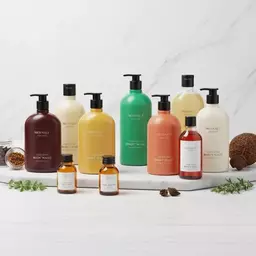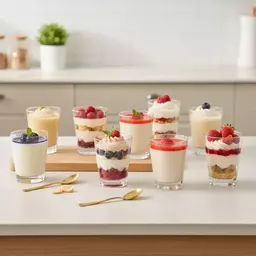Disposable Containers
- Single-use design
- Often made from polystyrene or polypropylene
- Typically used in takeout & catering
- Convenience for consumers
(Single-use, convenient)
Stay ahead with the latest packaging innovations and insights from Clara Voss and Innovative Packaging Solutions.
Posted on: 2025-09-28
By: Clara Voss
In a world increasingly focused on sustainability, choosing the right food containers can define not only operational efficiency but also your brand's commitment to the environment. As consumer preferences shift, understanding the differences between disposable and reusable options becomes essential for success.
An overview of key considerations when choosing between disposable and reusable plastic food containers, including benefits, limitations, and future trends.
(Single-use, convenient)
(Multi-use, sustainable)
(Convenience, sustainability, cost)
(Innovation in materials)
When it comes to food storage, selecting the right container can make all the difference! As the owner of Innovative Packaging Solutions, I've seen firsthand how these choices impact not only convenience but also sustainability and cost. In this section, we will explore the distinctions between disposable and reusable plastic food containers and why making an informed choice is crucial for your business and the environment.
Understanding the unique benefits and limitations of each type of container can significantly enhance your operations. From food safety to cost efficiency, let's delve deeper into the factors that can guide your selection. For more insights into the climate impact of reusable systems versus single-use packaging, you can refer to studies on the circular economy.
Choosing the right food container isn't just about convenience; it can affect your brand's image and operational efficiency. Here are some reasons why your choice matters:
At Innovative Packaging Solutions, we prioritize quality and sustainability in our offerings. Choosing the right packaging not only enhances your product presentation but also elevates your customer experience.
Before making any decisions, it's important to define what we mean by disposable and reusable containers:
Both types of containers have their place in the food industry, each serving different needs and operational strategies. Understanding these definitions helps you align your choices with your business goals and consumer expectations. Research on single-use versus multiple-use packaging provides further context.
Consumer preferences play a vital role in shaping the market for food containers. Factors influencing these choices include:
As we evaluate these preferences, it's clear that understanding what drives your audience can lead to better product offerings and marketing strategies. By aligning your packaging choices with consumer values, you can enhance satisfaction and loyalty.
When selecting between disposable and reusable containers, consider the long-term cost implications. While disposable containers may seem cheaper upfront, reusable options can lead to significant savings over time, especially for businesses with high turnover. Additionally, investing in eco-friendly reusable containers can enhance your brand's image and attract environmentally-conscious customers.
In today's fast-paced world, the push for sustainability is driving exciting innovations in food container designs. As the owner of Innovative Packaging Solutions, I’ve witnessed first-hand how the industry is evolving. We’re seeing a surge in demand for containers that not only meet functional needs but also prioritize sustainability. Let’s explore some of these trends and innovations that are reshaping the packaging landscape!
As we strive for a greener future, the materials used in packaging are becoming more diverse and eco-friendly. Some exciting emerging materials include:
By adopting these materials, businesses can not only reduce their environmental impact but also appeal to increasingly eco-conscious consumers. At Innovative Packaging Solutions, we're committed to exploring these options to enhance our product offerings.
The concept of a circular economy revolves around minimizing waste and extending the lifecycle of products. In the context of food containers, this means designing them for reuse, repair, and recycling. Key practices include:
By adopting these circular economy practices, we can significantly reduce waste and create a more sustainable future. It’s inspiring to see how companies are coming together to make this vision a reality! For more on how reusable take-out food containers can reduce plastic emissions, check out recent news from Tech Xplore.
As sustainability becomes a top priority for many consumers, businesses are responding with eco-friendly practices. Here are some notable trends we’re observing:
At Innovative Packaging Solutions, we embrace these trends by providing packaging that not only meets quality standards but also aligns with sustainable practices. As we move forward, it’s essential for all of us to stay informed and involved in these changes.
Disposable containers are designed for single use, often made from materials like polystyrene, and are convenient for takeout. Reusable containers are built for multiple uses from durable materials like glass or sturdy plastics, offering a more sustainable option.
Choosing high-quality and sustainable packaging reflects your commitment to quality and environmental responsibility. This can significantly enhance your brand's image and appeal to eco-conscious consumers.
Consumer preferences are primarily driven by convenience (ease of use and disposal), sustainability (desire for eco-friendly options), and cost (price sensitivity).
Emerging sustainable materials include plant-based plastics (biodegradable, renewable), recycled PET (rPET) which minimizes waste, and mycelium-based containers (made from fungi and agricultural waste, compostable).
Circular economy practices aim to minimize waste and extend product lifecycles through strategies like designing containers for easy disassembly, implementing take-back programs for used containers, and collaborating with recycling facilities to ensure proper recycling.
Here is a quick recap of the important points discussed in the article:

 Choosing the right planting method can significantly impact your gardening success. As a gardener, u
Choosing the right planting method can significantly impact your gardening success. As a gardener, u
 As brands strive to resonate with an increasingly personalized consumer base, the packaging of produ
As brands strive to resonate with an increasingly personalized consumer base, the packaging of produ
 In the world of foodservice, presentation and convenience are key. By embracing microwave-safe desse
In the world of foodservice, presentation and convenience are key. By embracing microwave-safe desse